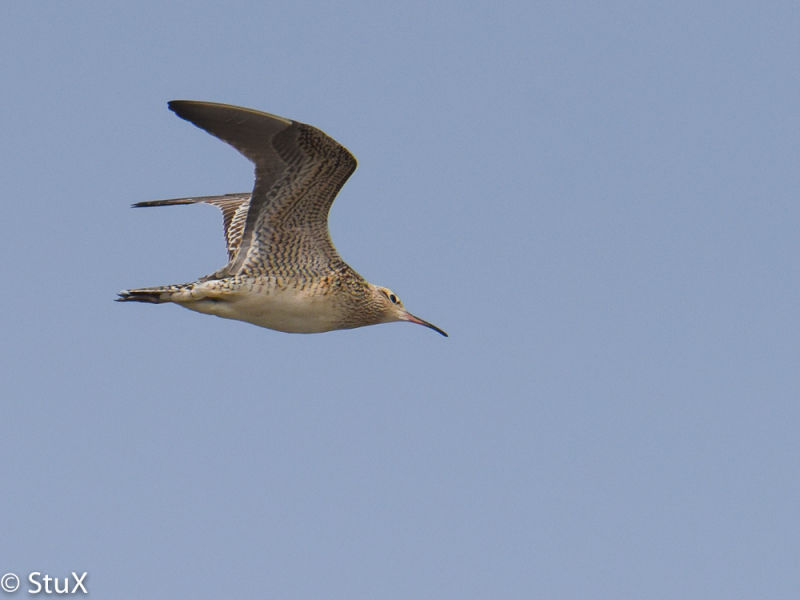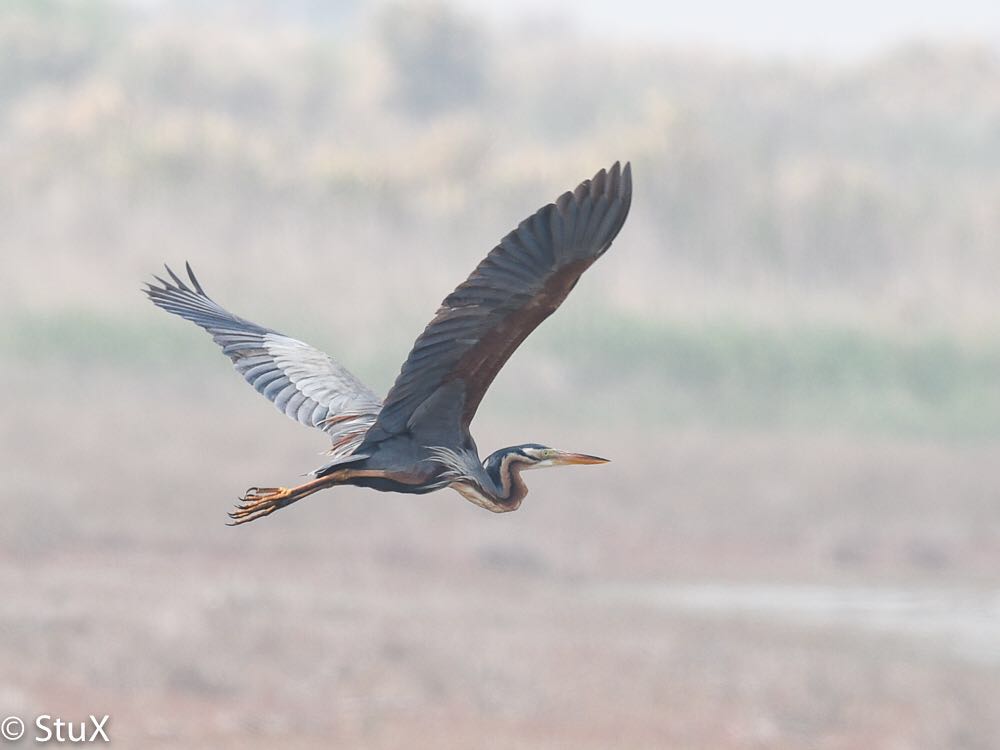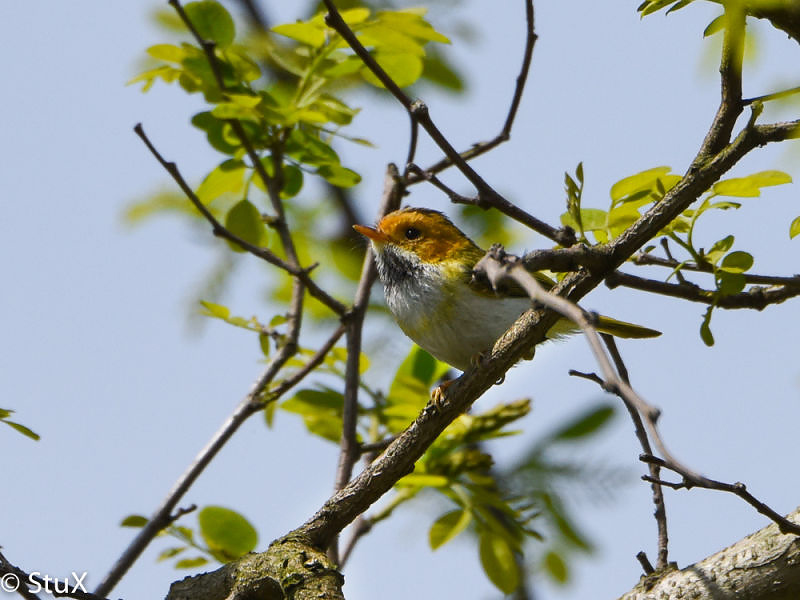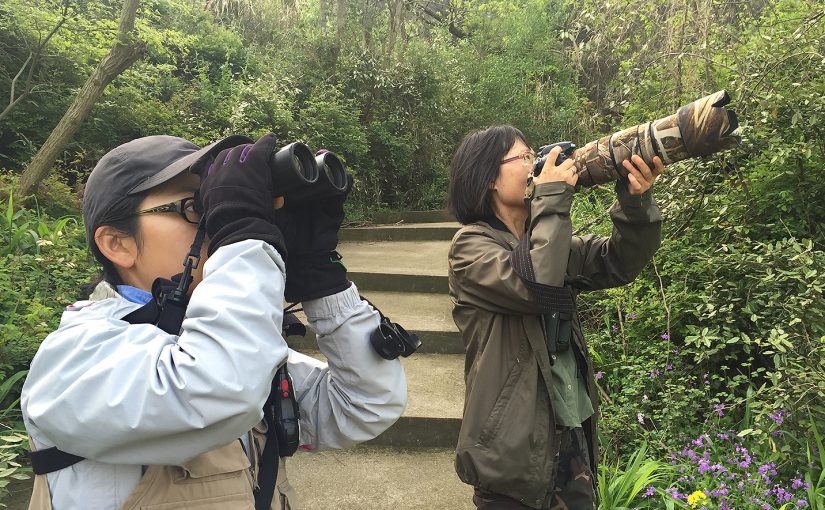by Craig Brelsford
Founder, shanghaibirding.com
From Thurs. 14 April to Tues. 19 April, Elaine Du and I combined inner-city birding (Century Park, Shanghai Botanical Garden) with suburban-coastal birding (Cape Nanhui, Lesser Yangshan). We noted 102 species. Sun. 17 April was the big day, with 95 species. Among them were 2 Chinese Egret and 3 singing Pale-legged Leaf Warbler on Lesser Yangshan and Rufous-faced Warbler, Swinhoe’s Minivet, and near-threatened Curlew Sandpiper at Cape Nanhui. Among our many firsts-of-season were 10 Narcissus Flycatcher, 4 Eastern Crowned Warbler, 2 members of the Arctic Warbler Complex, and Yellow-browed Bunting. With the spring migration rolling on strong, even the city parks gave us seasonal firsts, with Eurasian Woodcock and Blue-and-white Flycatcher at Century on Thursday and Eyebrowed Thrush Tuesday at the Botanical Garden. During the 6-day period, we noted 0 raptors, whether Accipitriform, Strigiform, or Falconiform.
When silent, as is most often the case in Shanghai even in spring, Pale-legged Leaf Warbler and Sakhalin Leaf Warbler are indistinguishable, and a typical bird list this time of year includes the entry “Pale-legged/Sakhalin Leaf Warbler Phylloscopus tenellipes/borealoides.” The songs of these lookalikes are, however, distinct, and on Sunday in the wooded areas of Garbage Dump Valley (30.644194, 122.058660) on Lesser Yangshan I sound-recorded the cricket-like song of P. tenellipes:
Pale-legged Leaf Warbler Phylloscopus tenellipes, song, Garbage Dump Valley (30.644194, 122.058660), Lesser Yangshan Island, Zhejiang, China, 17 April, by Craig Brelsford (0:22; 1.7 MB)
On Tuesday, Elaine and I found a silent pair; they were moving along thick branches in the manner of a nuthatch and pumping their tail, but because they were not singing we could not ID them beyond Pale-legged/Sakhalin.
Garbage Dump Valley also yielded Meadow Bunting, Brown-flanked Bush Warbler, and Manchurian/Japanese Bush Warbler, and Temple Mount (30.639791, 122.048244) gave us a single Goldcrest as well as Swinhoe’s/Pin-tailed Snipe.
On Sunday, Blue-and-white Flycatcher were noted in Garbage Dump Valley, on Temple Mount, and at Nanhui and on Thursday at Century. Each male was studied carefully so as not to miss Zappey’s Flycatcher, a recently recognized species that has been recorded in Shanghai (by Swedish birder Jocko Hammar in 2014). This spring, we Shanghai birders will do well to study each Blue-and-white Flycatcher carefully, in particular adult males, lest we miss Zappey’s. In Forktail No. 28, August 2012, Paul Leader and Geoff Carey write: “Males from populations that breed in central China [i.e., Zappey’s] are distinct from other populations in being blue or blue-green across the breast, throat and ear-coverts, and in having black or blackish restricted to the lores. … The upperparts are typically blue-green.” There are various other distinctions, not noted here.
For the first time we noted Marsh Grassbird north of the Magic Parking Lot/Holiday Inn (30.884992, 121.968317) at Nanhui. This new location is on the road leading into the reed bed and lined with street lamps. Another, larger location is 30.870265, 121.933950, a point 2.8 km south of the lock at Nanhui and 4.1 km south of the Magic Parking Lot/Holiday Inn. We discovered Helopsaltes pryeri at the southern location on 10 April and found them there again Sunday. 3 Reed Parrotbill were in the area, and Pallas’s Reed Bunting, so numerous just a few weeks ago, were nearly absent, most of them having departed for breeding areas north.
The Chinese Egret were our reward for never failing to scrutinize groups of Little Egret. Sure enough, our Egretta eulophotes were associating with 3 E. garzetta on a taut anchor line tethering a boat to the bottom of a little bay along Gangchi Road (30.612507, 122.105993). We are not sure whether our view is a one-off or whether something about that bay is attractive to that species.

At the Accidental (and probably Temporary) Wetland on Lesser Yangshan, we found the 2 Little Curlew, 1 of our 2 Garganey, Purple Heron, Black-tailed Godwit, 1 of our 6 Pacific Swift, 18 of our 80 Sharp-tailed Sandpiper, 2 Red-rumped Swallow, and Oriental Reed Warbler. Accidental Marsh sits on land reclaimed when a causeway was built linking Lesser Yangshan and Dazhitou Island. The coordinates of this spot are 30.611902, 122.114873. Bird this spot while the birding is good!
On Thurs. 14 April, Elaine and I birded Century Park, noting 31 species. 2 Eurasian Woodcock were seen in the forested area near Gate 7 known as “Woodcock Forest” (31.215413, 121.547678). There were impressive flocks of Brambling, 72 in all. Other highlights: Eurasian Hoopoe 1, Pale Thrush 23, White’s Thrush 2, and Chinese Blackbird 40, among them 2 fledglings.
The encounter with the woodcocks occurred just a few meters from the point where Elaine and I found this species last 30 Oct. Woodcock Forest is usually devoid of humans, and forest species tend to pool there. For best results, tiptoe in and scan silently. Do not forget to look into the canopy; I have seen sparrowhawks there.
We found no Yellow-bellied Tit, the only leaf warbler we found was a single Yellow-browed Warbler, and we thought low our count of just 1 Grey-backed Thrush. There were no other flycatchers besides the Blue-and-white.
As I have noted many times before, thieves are active at Century. On Thursday I had the unusual experience of thief-watching. Two folks were sitting on a park bench looking out over the lake. Elaine and I were standing far behind and noticed an ugly man in ratty clothing approach the couple from the forest behind them. He was moving in a catlike manner and was either casing the couple or was about to snatch something. I moved in noisily, and he slunk off.
This thief and others in his gang must be skillful, otherwise they wouldn’t have operated in the park so long. Their booty is phones, wallets, and purses, their victims distracted persons relaxing in the park. To avoid falling prey, keep your phone zipped in your pocket, leave nothing lying around, and use your powers of observation honed through birding to assess the people around you.
On Tues. 19 April, a walk through the Shanghai Botanical Garden netted Elaine and me 28 species. 2 Japanese Tit fledglings were following their parents and making begging calls, 4 Common Sandpiper were in Zhāngjiātáng Hé (张家塘河), and White’s Thrush, Grey-backed Thrush, Pale Thrush, and Eyebrowed Thrush were found in a quiet wooded area (31.147780, 121.438917) along the stream.
Sunday marked the reunion of the five-member Dream Team after a winter hiatus. Husband-wife members Stephan and Xueping Popp took many fine shots, and Stephan once again performed skillfully behind the wheel. Senior Birder Michael Grunwell combined sober experience with boyish enthusiasm, the latter particularly in evidence when he beheld Narcissus Flycatcher, a lifer for him. Elaine did her usual fine job keeping the list. Though I’m making a quick recovery from my intercostal muscle strain suffered 10 April, still I traveled light, eschewing photography and using only binoculars.
PHOTOS


Featured image: Elaine Du (L) and Xueping Popp scan for leaf warblers in Garbage Dump Valley on Lesser Yangshan Island, Sun. 17 April. (Craig Brelsford)


Hi Craig,
Nice birding! I am thinking of coming to China in July for hiking and chasing wildlife. just wondered if you had any thoughts on Changbai Shan area near Jilin vs. QilianShan near Lanzhou. Aim is to find some unspoilt areas…but still fairly accessible
Best
Mark
Hi Mark, I understand and applaud your desire to strike a balance between accessibility and newness. I have not yet visited the Changbai Mountains. I have visited the Qilian Mountains, a northern offshoot of the great Kunlun Range. I was awestruck by the beauty of those white peaks rising from the desert. I visited the Qilian Mountains near Subei in western Gansu. Permits to reach the best areas were nearly impossible to get; foreigners are effectively banned from the nature reserves. I do not know the situation in the more eastern parts of the Qilian Mountains. For more on my time in the Qilian Mountains, do a CTRL + F search for “Qilian” in my report, “Qinghai and Gansu, July 2014.”